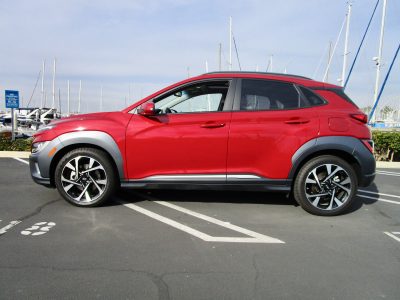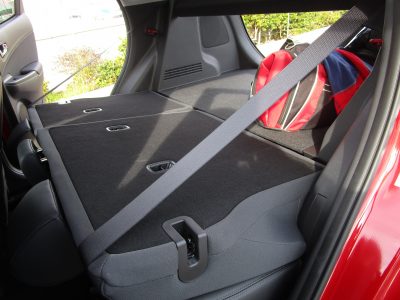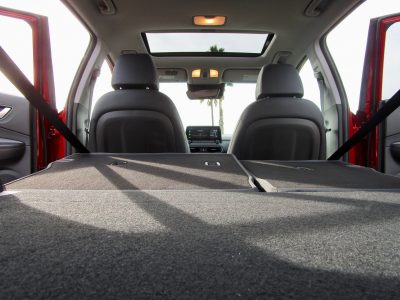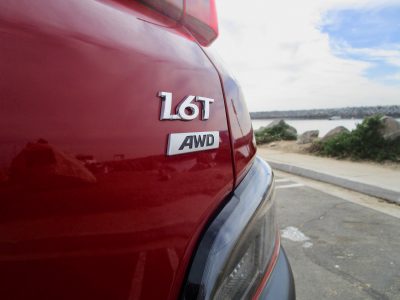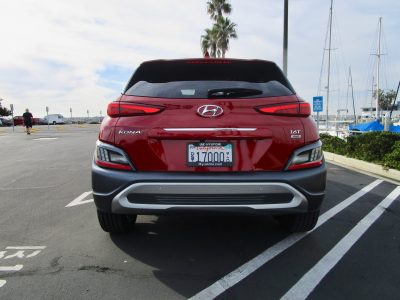Well, we’re spending the holidays in Kona. No, not the balmy town on the Big Island of Hawaii (we wish) but something nearly as fun – the heavily revised 2022 Hyundai Kona. It’s long been one of our favorite small SUV’s – especially if you pony up for the turbocharged model. So, does it remain a vacation from other sleepy small SUVs? Let’s take a look.
Go For the Bold
The exterior has gotten a major freshening, and while we were frankly pretty happy with previous design, we’ve got no complaints with the new duds. Up front, a larger split grille gives an aggressive look, while the Hyundai logo has moved above and now sits on the longer hood. New LED running lights look slimmer and meaner, while the lower fascia is more pronounced, giving a rugged, off-roady vibe.
The profile remains a combination of cute and chunky, with a more pronounced shoulder line that offsets the cladded fender flairs. We especially liked the new-design, 18-inch alloy wheels.
The rear gets a nice redo as well, with cleaned up LED rear taillights, while a lower contrasting fascia gives some added visual width, and makes the Kona look a bit more hunkered down. We also liked the bold Pulse Red exterior color that matches the vibe. This Kona is no wallflower!
Movin’ on Up
Inside, Hyundai has made subtle changes that make you feel like you’re in a more expensive product. Immediately catching your eye is the Limited’s 10.25-inch digital dash display, that’s simple and clean, but does some nice stuff like change from a silvery white in normal mode to an angry red in sport mode. We also like the little things like a display that shows when you change settings on the wipers or headlights – no craning to read the small writing on the stalks.
Serving up info-tainment is a 10.25-inch touch screen display (lesser models get an 8-inch display), that’s nicely laid out with added buttons underneath, which looks a bit more elegant than the old system’s toggles on either side of the screen. And Hyundai shows it knows what buyers want – good old-fashioned knobs for volume and tuning!
All Kona models feature Apple CarPlay and Android Auto, and we still find the Hyundai system one of the easiest to use, with a quick handshake with your phone, and simple on-screen layouts.
The quality of materials is nice – we loved our tester’s standard leather, and the aluminum-tone trim. The leather wrapped wheel and chunky shifter feel great in your hands, too. The redesigned turbine-look air vents are classy, too. And the electric parking brake is lux. Less upscale, we did notice a fair amount of hard cheap looking plastics – a reminder of the vehicle’s economy roots.
We did appreciate a load of standard features that came on our Limited trim, including power moonroof, dual-zone AC, harmon kardon audio system and wireless charging. There’s even available Digital Key which lets you access everything you need through your smartphone, so you can choose to leave your key at home if you like. Techy!
Hyundai says the second row legroom has been improved, but it is still tight for adults on longer trips – but the same can be said for any of the direct competitors like the Mazda CX3. Same goes for the cargo area. If you carry lots of stuff, take a closer look, And if you find you need more room, it’s an easy step up to the Hyundai Tucson, which we recently tested and liked a lot.
Turbo Fun Time!
Those small dimensions have their advantages – it makes the Kona feel more like a sports car than an SUV!
You actually have a few choices in powertrains, including a 147-horse 2.0-liter, 4-cylinder, and our favorite, the 1.6-liter turbocharged 4-cylinder. It’s a mighty little engine, kicking out 195 horsepower, and 195 lb.-ft. of torque at just 1,500 rpm. That’s a load of responsive power for a relatively lightweight vehicle, and with 0-60 in just around 6 seconds, the Kona is one of the quickest small SUV’s.
Also in the hopper are a Kona EV, as well as an upcoming N-Spec that serves up a mouth-watering 275 horsepower. We look forward to testing both!
Back to our little rocketship, the turbo is connected to a 7-speed DCT transmission that shifts ultra-quickly, especially in Sport Mode. Hyundai says they have retuned the transmission for 2022, but to be honest, we did have issues with the transmission stumbling at very low speeds, making traffic and parking a bit less fun. But once you’re up and rolling, the DCT makes up for those mis-steps with exhilarating response.
With all that power, we were glad to have the optional all-wheel drive, which doles out the power efficiently for great grip (we got a chance to drive our Kona in a heavy rainstorm), and also makes it a ball to throw around on your favorite twisty roads.
But this is no hard-edged sports car, the ride is surprisingly supple, thanks to the tall-ish small SUV suspension, and it reminds us of how Audi and Subaru like to set up their AWD chassis. So, you get a very comfortable way to get around, along with your heaping hot serving of fun!
You can also feel confident with a suite of state-of-the-art safety features. Depending on the trim you choose, the more features you get, but it’s noteworthy that on the 2022 model, the Blind Spot warning can now engage the brakes if you try to change lanes with a vehicle detected in your way, and a new Highway Drive Assist feature helps keep the Kona in the center of its lane while maintaining the distance from a vehicle ahead. It can even make speed adjustments according to the posted speed limits on interstate highways. Cool!
Can I Afford to Live on Island Time?
Yes, you can! Prices for the Kona start at just $21,500 for a front wheel drive SE. For a fun, efficient small SUV, that’s a bargain. We are really sold on the turbo engine, so we would at least step up to the new N Line trim, which gets you the more powerful engine, and some sporty looks for a very reasonable $25,700.
Our top of the line Limited started at $28,450. Add in AWD ($1,500), and Destination ($1,225) and we rang the bell at $31,175.
Competitors would include the turbocharged Mazda CX30. It’s a bit larger, more upscale, and powerful with a 250-horsepower, 2.5-liter engine. But at $35,995 it’s also a significant step up. The non-turbo CX 30 is a good choice – but won’t match the thrill for dollar of the turbo Kona.
We’d also look at the Kona’s sibling the Kia Soul. The top-of-the-line turbo model (same engine as the Kona) comes in at just under $29,000, but you need to factor in that AWD is not available on the Soul. So, they are actually similar in price. We love the Soul’s fun and chunky style, while the Kona comes across as a little more mature and luxurious. If you’re looking at one, you should definitely drive both.
With fresh looks, some exciting updates, and delightful turbo performance, we were thrilled to spend our Holidays in Kona – the 2022 Hyundai Kona Limited!

Ben Lewis grew up in Chicago, and after spending his formative years driving sideways in the winter – often intentionally – moved to sunny Southern California. He now enjoys sunny weather year-round — whether it is autocross driving, aerobatics, and learning to surf.





